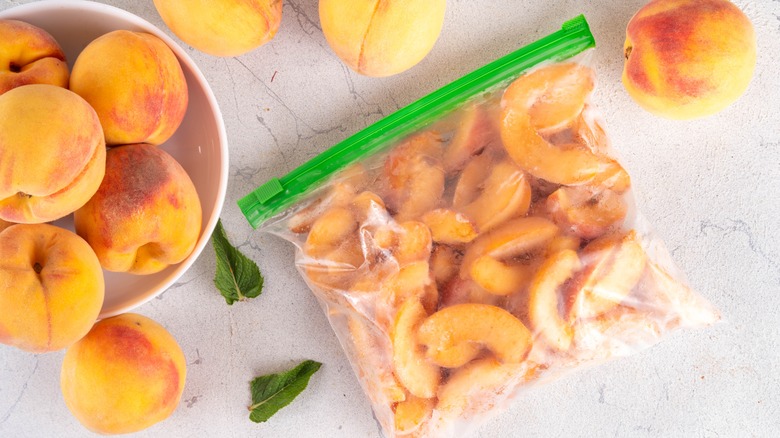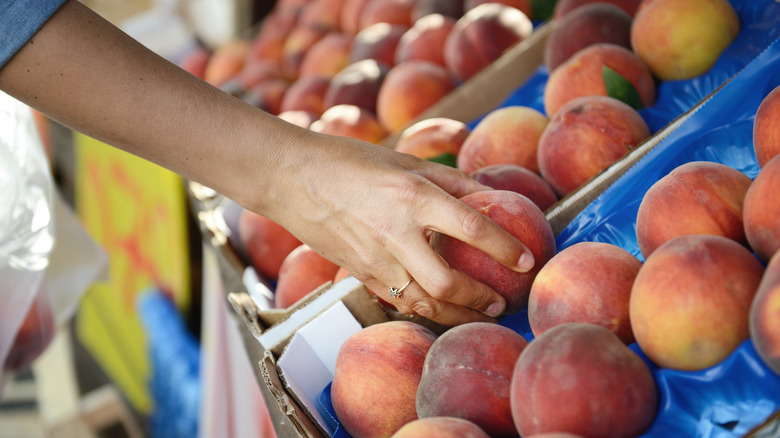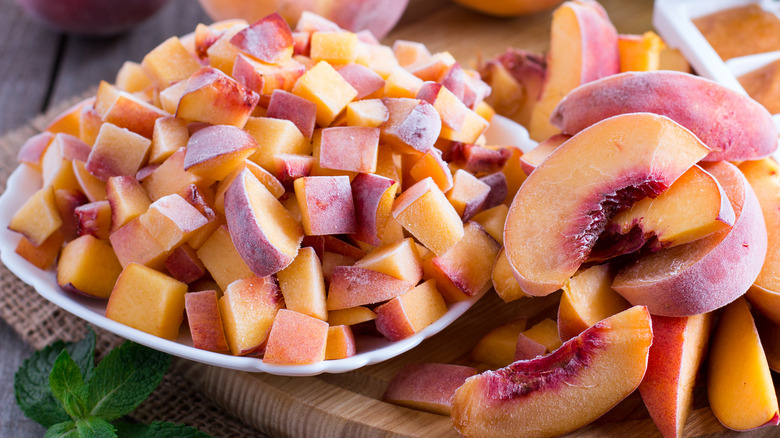How To Properly Freeze Peaches For Long-Term Storage
Canned peaches are fine for some things, but we all know nothing beats the fresh peaches that go right from the tree to your hand. Even though peach season is generally in the summertime, peaches are one of those fruits that freeze really well, fortunately. If done right, you can definitely keep peaches on hand for a mid-winter cardamom peach cobbler or up to a year.
And if you're wondering whether it's better to use canned or frozen peaches for desserts like that peach cobbler, don't worry! Frozen peaches are a perfect alternative to fresh, particularly if you plan ahead and let them thaw beforehand. That will prevent your dessert from becoming too watery, and it also means that you have zero reason not to stock up on some fresh peaches and freeze them for later.
That said, there are a few tricks to this — and it starts with choosing the right peaches to freeze. Peach varieties generally fall into two main categories: freestone and clingstone. Clingstone peaches are usually smaller and sweeter, but their pits are attached to the flesh. Freestone peaches, on the other hand, have pits that don't stick to their flesh — and that makes them much better for freezing. Opting for freestone varieties will allow you to get cleaner, neater slices. They start appearing in the middle to the end of the season, so keep that in mind when planning your peach-freezing journey.
Here's how to choose the right peaches for freezing
Aside from the type of peach, you also have to be mindful of the peach's state of condition. Despite the long-standing debate over the quality of fresh, frozen, and canned fruits and vegetables, it's often the frozen ones that come out on top. This is especially true if you're buying produce shipped in from out of state because frozen fruits and veggies are harvested, and then frozen immediately to preserve quality, taste, and nutritional content. The same idea applies to the peaches you're freezing at home, so when you're choosing what you're going to freeze, keep in mind that you're going to want to preserve them when they're perfectly ripe.
Fortunately, there are some telltale signs to look for, including a firm texture with just the slightest bit of softness when squeezed. Look for a reddish color and a strong, peachy smell, and make sure there's no bruising or spots on the skin.
Don't worry, it's easy. Once you know what to look for, you'll learn how to prep and freeze them, including in a delicious syrup perfect for pies, cobblers, and crumbles.
There are several great options for freezing peaches
The key to properly freezing peaches is to blanch them first, a process that involves cutting a cross into the skin of the peach — usually on the bottom — then giving them a 30-second soak in boiling water. Why blanch? Blanching stops enzyme activity and potential bacterial growth and helps preserve that oh-so-incredible juiciness. Afterward, transfer them to an ice bath, and if you want to peel them, you can, though it's not necessary.
Then, simply cut your peaches into slices (or cubes). Cover them with a layer of sugar or brush them with water to help preserve their integrity, then place them on a baking tray in a single layer. Let them freeze before transferring to a freezer-safe bag or container.
Alternatively, you can also freeze them in water or sugar syrup. Making your own simple syrup is easy to do. While the kind you use for cocktails is generally made with a 1:1 ratio of sugar and water, you should consider using a 3:2 ratio of water and sugar for packing your peaches. Melt the sugar in the water, allow it to cool, and add your peach slices to a freezer-safe container. Fill with syrup — leaving enough room for expansion during freezing — then seal and freeze. Since this is perfect for future projects like pie, you may consider freezing your peaches in batches equivalent to the amount you'll need for a single use.


